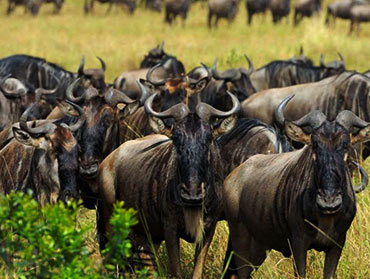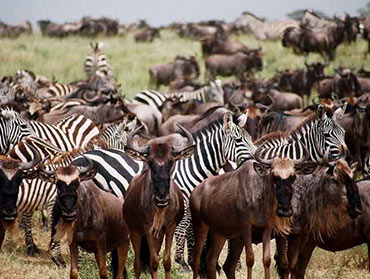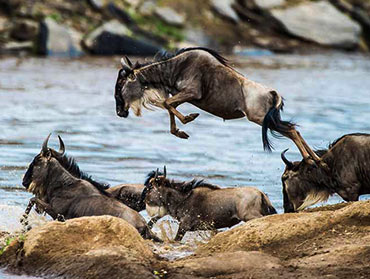
Longido is situated about 80 kilometers north of Arusha on the way to Nairobi, just at the foot of Longido mountain, which rises up steeply from the plains and forms an important orientation point for people in the wide surroundings. On the mountain and the surrounding plains, the Maasai warriors wander about with their cattle looking for pasture and water. Once a week, on Wednesdays, the cattle are herded to a cattle market in Longido town. Maasai families live in traditional bomas scattered over the area. In the early morning, women leave the boma to fetch water and collect firewood. Young children play around the mud houses and start at a very early age to take care of kids and lambs.
An abundance of colorful birds can be found in the area. The startling major, the red and yellow barbet, the masked weaver, the silverbill and the secretary birds are some of the species to be seen. Longido is further well known for the presence of rare mammals that cannot be seen in any of the national parks. The plains and the slopes of the mountain form the refuge for the gerenuk, the lesser kudu and the klipspringer. Among other mammals living around Longido are giraffes, zebras, gazelles, buffaloes, mongooses and some silver jackals. Half a day tour: You make a “bird walk” on the Maasai plains from the town of Longido to the bomas of Ol Tepesi. The Maasai guides will help you spot many colorful birds and also show you trees and plants that they use for preparing food and medicines. At Ol Tepesi, which is the Maasai word for acacia tree, the guides will invite you into a Maasai boma and show you the traditional way of life. Since it is known that tourism-programs sponsor the cattle dip, you always get a warm welcome.
The one-day tour adds a walking safari from Ol Tepesi to Kimokouwa, along a narrow Maasai cattle trail that winds over the slopes of Longido Mountain. In two hours time, you gradually climb from the plains at an altitude of 1,200 meters to a hilltop of 1,600 meters. On clear days you have beautiful views of Kilimanjaro and Meru, and once you have arrived at the northern side of the mountain you can oversee the Maasai plains till deep into Kenya. The last hour you descent to Kimokouwa, where several Maasai bomas are peacefully situated in the green “valley of wells.” Nearby you can visit a historic German grave.
Tourists with strong legs longing for adventure can climb the 2,690 meters high mountain. The first day you walk to the campsite of Kimokouwa.
Guided by Maasai warriors you leave the campsite early in the morning and follow narrow footpaths through a dense forest. After three hours you arrive at the “dawa ya supu” (medicine soup) viewpoint. From here you will follow the trails created by buffaloes to reach the top in another 2 hours climb. With loud cries the Maasai warn the buffaloes that people are coming to avoid dangerous encounters. On clear days you can look more than 200 kilometers far and see all mountains of Northern Tanzania. The descent of the steep mountain is another challenge. In three hours time you arrive at the campsite, have a rest and in another hours and a half you reach the jeep road where a car is waiting for you. In the evening you enjoy a meal prepared by the FARAJA women’s group. On Wednesdays you can extend your stay with a visit to the bustling colorful cattle market.
Our guides are young Maasai who grew up in the area. They speak some English and further use hand signs to show you the beauty of Longido. They know all attractions and dangers, and have received tourism training. On walking safaris Maasai warriors armed with knives and spear protect you from animals.
In Longido you can spend the night in guesthouses or put up a tent at campsites at the foot of the mountain. The guesthouses are simple, but clean, and always have a toilet and bathroom. On request warm water will be made for you. The FARAJA women’s group, who has developed a catering service for the campsites in the area, will prepare meals.
Cattle diseases are one of the main problems the Maasai are facing in Longido. Each year about 1,000 cows die, mainly because of tick-born diseases. Since Maasai life is centered on livestock, this can create quite serious problems. A reduction of the herd size means less work, less income and less food. Preventing cattle diseases is of major importance to the Maasai. Regularly dipping will kill all ticks and eradicate tick-born diseases. The only cattle dip in Longido is however out of order. During socialist times the dip belonged to the whole community, and therefore no one really felt responsible for it and the dip became neglected. Now the Maasai have established a committee, which is going to rehabilitate the dip, this is almost finalized. Part of the income generated from tourism has been used for this purpose, and 15 water distribution points have been installed in Kimokowa village.

Explore some of the best tips from around the city from our partners and friends...

Explore some of the best tips from around the city from our partners and friends...

Explore some of the best tips from around the city from our partners and friends...